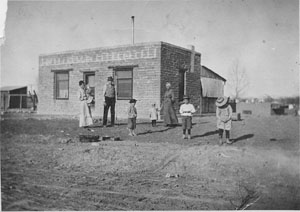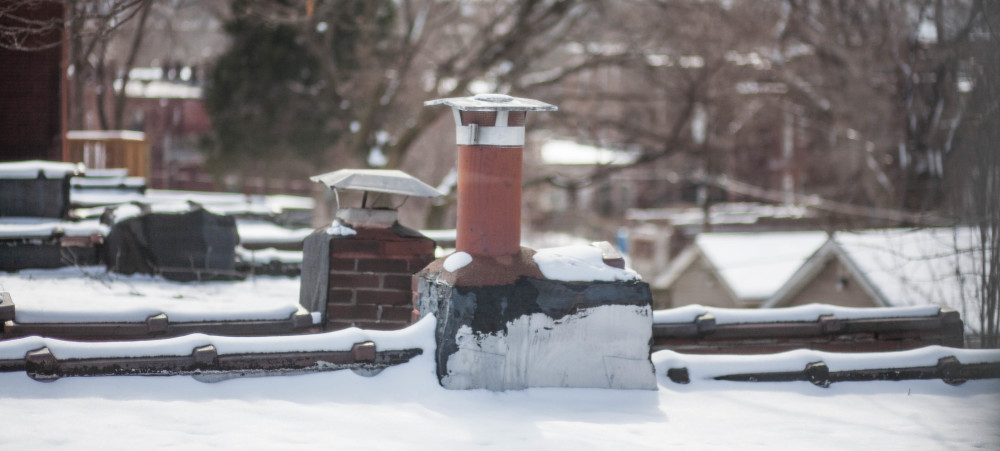Under some rubric listing quaint, old-fashioned expressions, I might list the word receipt. I was puzzled as a child that my Grandma Long used receipt to mean recipe, until I learned as an adult that the two words have overlapping etymologies. In receipt of is another quaint expression to my ear, sometimes regarded as stuffy and falsely formal. Nevertheless, I am in receipt of two letters that have caused my heart to swell; though both speak of hardship.
The two letters are included in a cache of my Grandma Long’s keepsakes for which I am grateful to my cousin, Marion Choate. Marion’s mother was my Aunt Frances, my father’s younger sister. So let’s start back with the photo of my father’s family I have cited previously. A note attached tells me it was taken on January 1, 1911, but that can’t be correct because my uncle Bill, the baby in my grandmother’s arms, was born March 1, 1912. Perhaps January 1, 1913 is the correct date.

I don’t know the exact date of my family’s arrival in Las Cruces, but the earliest deed to the property in this photograph that I find among my grandmother’s keepsakes is dated January 20, 1912. The land was apparently not a homestead in the strict sense. Though my grandmother’s papers include several documents pertaining to the farm property, the process by which she and my grandfather acquired it is still not clear to me. In this photo it appears a hardscrabble place, but here’s how one of his obituaries describes my grandfather and his farm.
Mr. Long was born in 1879 at Minneapolis, Minn., thus being 39 years of age at the time of his death. Later the family moved to Missouri, Mr. Long moving from there to Oklahoma, where he was engaged in the newspaper business for a number of years, until seven years ago when he came to the Rio Grande Valley for the benefit of his health.
Mr Long took a small place on the outskirts of town and in spite of the handicap of il [sic] health had made a success of it and had one of the nicest little homes in the valley at the time of his death. He acquired a reputation as a very successful grower of vegetables and as one who was peculiarly conversant with farming conditions in the valley.
I could guess that my grandfather arrived in New Mexico very early in 2012. The ill health referenced in the obituary was tuberculosis; though my grandfather died in the flu epidemic of 1919 as I’ve noted previously. He had tried a sanitarium in Colorado before going to New Mexico. In the early twentieth century not much could be done for tuberculosis, though it was thought that dry climates were better for the afflicted than wet ones. I make it also that my grandfather arrived in New Mexico in advance of his wife and children, who by this reckoning might have arrived between January and March 1912.
I’m not comfortable with these dates, however, think the family could all have arrived the previous year and it could have taken them a while to get settled on the farm. When I last visited with my Uncle Randolph, around 1992, he told me that my grandfather had gone to New Mexico first and that my grandmother and the children first traveled by train to San Antonio, Texas and then traveled from there to Las Cruces in a covered wagon. My memory is that Uncle Randolph said these events occurred in 1911. The difficulty with my projected dates in 1912 as the time of the family’s trek to the Rio Grande Valley is that at that time my grandmother would have been in the last stage of her pregnancy with my Uncle Bill. Some light may be shed on this question and others by a letter I found among my grandmother’s keepsakes from my great grandmother, Melinda Akers Long, whose grave I was unable to find last fall. I’ll quote the entire text, though it is a bit lengthy.
R. 4. Hico Texas
May 23 – 1912Dear Olin & Adda
Your letter of the 18th came this week. I am quite strong again and am enjoying Texas very well. Marian and I took a buggy ride this afternoon to see the new baby girl at Cashiou’s. We also had quite a chat with Mrs. Autrey as we came home. Hico school will close tomorrow and then Vernon will be at home. He has done well in school and is so large and strong that he can do considerable work at home. He chops cotton pulls weeds and cuts wood evenings and Saturdays and of course can accomplish more when school is out. Atticus is also very large for his age and talks so plain that he does not seem like a baby. He carries a little hoe in the field and tries to use it much of the time.
Well, I certainly am glad that you are in your own house and are able to work. I hope nothing will successfully tempt you to do more than you ought and hinder your complete recovery. Marian found several ripe strawberries this evening so you can guess what we will be doing.
You may know it seems somewhat better to be here with Marian and well than to be at Sayre sick and the neighbors waiting on me.
Lovingly,
Mama
First things first—my great grandmother was chronically ill. Though she claims to have recovered, she would barely live out the year. The cause of death listed on her death certificate is “La Grippe [influenza] complicated with bronchitis—pneumonia.” I’m guessing that she, too, had tuberculosis. The date of this letter suggests that she had just recently heard from her son that he and his family were settled, but her comment about being “in your own house” leaves open the possibility that the Las Cruces Longs had arrived previously and stayed in rented quarters for a time.
I also learn that my grandfather was known as Olin, a fact that is confirmed by another letter from an aunt in Kansas at the time of his mother’s death in 1913. I’ve mentioned the hardship reflected in these letters. My great grandmother’s mention of cotton indicates that her daughter, Marian Curtis, and her family were not merely engaged in subsistence farming in Texas but were raising a money crop as well; and her recounting of the activities of her grandson, Vernon, who was seven (or possibly eight) years old in 1912, says a great deal about how much human labor was required by their way of life. The other grandson, Atticus, who had been named for his father’s brother, would die late in 1913 of an unspecified illness that had lasted seven months. Atticus died in Pecos, Texas, at his namesake’s home. That his parents had sent him west to live with his uncle suggests to me that he may have contracted tuberculosis as well. The image of a dying boy trying to chop cotton with a small hoe speaks poignantly of the lives of these folk.
And all these folk, the Longs, the Petersons, and the Curtises had first settled in and around Sayre, Oklahoma between 1900 and 1905. At that time what would become Beckham County had just been opened to Anglo settlement. Quannah Parker still lived at his Cache establishment not far away. The place had been part of Comancheria and before that Apacheria—before the expansionist Comanches drove the Apaches off the plains. But the Southwest was changing fast. The Longs, Petersons, Curtises, and folk like them would inherit much of it.
To be continued . . .
